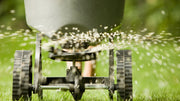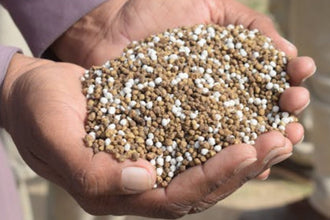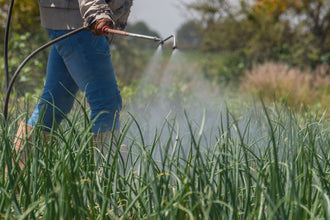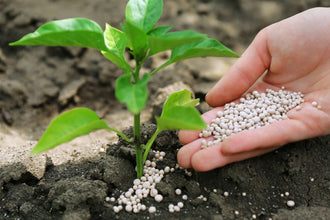
Using a fertilizer spreader the right way can make or break your lawn and garden game. You've probably seen those yards with perfect green grass and wondered how they do it. Meanwhile, your lawn might look patchy with brown spots here and green patches there. The secret isn't some expensive miracle product. Most of the time, it comes down to how you spread your fertilizer.
Getting even coverage sounds easy, but plenty of things can go wrong. You might end up with stripes, burnt spots, or areas that stay yellow no matter what you try. The good news is that once you know what you're doing, a fertilizer spreader becomes your best friend for creating that picture-perfect yard everyone envies.
Understanding Different Fertilizer Spreader Types
Not all spreaders work the same way. Picking the wrong type for your situation is like trying to paint a house with a toothbrush. Sure, it'll work, but you'll waste time and get frustrated. Each type has its sweet spot where it really shines.
The three main types each handle different jobs better than the others. Some work great for big open areas, while others give you pinpoint accuracy for smaller spaces. Knowing which one fits your needs saves you money and headaches down the road.
Broadcast Spreaders Work Best for Large Areas
Broadcast spreaders fling fertilizer out in a wide pattern as you walk. Picture someone scattering seeds by hand, but way more consistent. These spreaders have a spinning plate underneath that throws fertilizer as you push the spreader forward.
Most broadcast spreaders cover about 8 to 12 feet with each pass. This makes them perfect for big lawns or large garden areas. You can cover a lot of ground quickly without making dozens of trips back and forth.
The downside is they're not super precise. Wind can blow lightweight fertilizer around, and it's easy to accidentally get fertilizer on your driveway or flower beds. But for covering large, open spaces fast, nothing beats a good broadcast spreader.
Drop Spreaders Give You Precise Control
Drop spreaders release fertilizer straight down through holes in the bottom. The fertilizer only goes where the spreader goes, which gives you complete control over placement. No worrying about wind or fertilizer landing where you don't want it.
These work great for smaller yards or when you need to be really careful about where fertilizer goes. You can get right up to sidewalks, flower beds, or your neighbor's property line without making a mess.
The trade-off is speed. Drop spreaders only cover their own width, usually 18 to 24 inches. This means more walking and more time to cover the same area. But if precision matters more than speed, drop spreaders are hard to beat.
Handheld Spreaders Handle Small Jobs
Handheld spreaders are like the Swiss Army knife of fertilizer application. They're small, portable, and perfect for spot treatments or tiny gardens. Most hold between 2 to 5 pounds of fertilizer, which is plenty for treating problem areas or small spaces.
These little spreaders shine when you need to treat individual plants or work in tight spaces between plants. They're also great for applying different fertilizers to different areas of your garden.
How to Choose the Right Fertilizer Spreader
Picking the right spreader depends on your specific situation. Your yard size, terrain, and how precise you need to be all factor into the decision.
Think about your property first. A quarter-acre lawn needs a different approach than a small city backyard. Large areas benefit from the speed of broadcast spreaders. Smaller spaces work better with drop spreaders or handheld units.
Your terrain matters too. Flat, open areas work with any spreader type. Hills, slopes, and lots of obstacles make some spreaders harder to use than others.
Consider Your Property Size
Here's a simple rule: bigger properties need bigger, faster spreaders. Walking behind a tiny drop spreader on two acres will take forever. On the flip side, wrestling with a huge broadcast spreader in a small backyard is overkill.
For most home lawns under half an acre, a good broadcast spreader works well. Properties larger than an acre might benefit from a pull-behind spreader you can attach to a riding mower or ATV.
Don't forget about storage either. Large spreaders need somewhere to live when you're not using them. Make sure you have space in your garage or shed before buying a monster spreader.
Think About Your Terrain
Slopes and hills make spreading fertilizer trickier. Broadcast spreaders can throw fertilizer downhill, creating uneven coverage. Drop spreaders work better on slopes because the fertilizer goes straight down.
Lots of trees, flower beds, or other obstacles favor more precise spreaders. You'll spend less time cleaning fertilizer off places where it doesn't belong.
If your yard has both large open areas and detailed spaces, you might need two different spreaders. Many people use a broadcast spreader for the main lawn and a handheld unit for detail work.
Setting Up Your Fertilizer Spreader for Success
Getting your spreader set up correctly prevents most application problems. This step is where many people mess up, but it's actually pretty straightforward once you know what to do.
Every fertilizer bag has recommended spreader settings printed right on it. These settings work for most popular spreader models. Start with the recommended setting and adjust from there if needed.
Calibration sounds technical, but it's just testing your spreader to make sure it puts out the right amount. This prevents expensive mistakes like burning your lawn or wasting fertilizer.
Basic Calibration Steps
Here's how to calibrate your spreader without getting too complicated about it:
-
Fill your spreader with enough fertilizer for your whole yard
-
Mark off a test area that's 10 feet by 10 feet (100 square feet)
-
Set your spreader to the recommended setting from the fertilizer bag
-
Apply fertilizer to your test area at normal walking speed
-
Weigh the fertilizer left in your spreader
-
Subtract the remaining weight from what you started with
This tells you exactly how much fertilizer you applied to 100 square feet. Compare this number to what the bag recommends. If you applied too much, turn down the setting. If you applied too little, turn it up.
Write down your final setting somewhere you won't lose it. Different fertilizers might need different settings even on the same spreader.
Getting the Right Walking Speed
Your walking speed affects how much fertilizer gets applied. Walk too fast and you'll under-apply. Walk too slow and you'll over-apply. Find a comfortable, steady pace and stick with it.

Most people walk about 3 miles per hour normally. This speed works well for most spreaders and fertilizers. Practice walking at a steady pace before you start spreading.
Mastering Fertilizer Spreader Application Techniques
Good technique makes the difference between professional-looking results and a patchy mess. The way you walk, turn, and overlap your passes all matter more than you might think.
Planning your pattern before you start prevents missed spots and double applications. Both problems show up weeks later when your grass starts growing differently in various areas.
Creating Your Application Pattern
For rectangular areas, work in straight, parallel lines. Start along one edge and work your way across. This pattern is simple and covers everything evenly.
Overlap each pass by about 6 inches. This prevents those annoying strips of under-fertilized grass that show up later. But don't overlap too much or you'll double-dose some areas.
Turn off your spreader when you reach the end of each pass and turn around. Turn it back on as you start the next pass. This prevents heavy applications in the turn-around areas.
Dealing with Wind and Weather
Wind messes with broadcast spreaders more than any other factor. Even a light breeze can blow fertilizer off target. Try to spread fertilizer on calm days whenever possible.
If you must spread in windy conditions, adjust your technique:
-
Walk perpendicular to the wind direction
-
Reduce your spreader opening slightly to compensate for drift
-
Make more passes with less overlap to ensure even coverage
Rain within 24 hours of application helps nutrients soak into the soil. But heavy rain right after spreading can wash fertilizer away before plants can use it. Check the weather forecast before you start.
Working Around Obstacles
Gardens with lots of trees, flower beds, and other obstacles need special attention. Use these techniques to get clean, precise applications:
-
Outline the perimeter first with a drop spreader or by hand
-
Fill in the open areas with your broadcast spreader
-
Keep handheld spreader for tight spots and detail work
-
Use cardboard or tarps to protect areas where you don't want fertilizer
Common Fertilizer Spreader Mistakes That Ruin Results
Even experienced gardeners mess up spreader applications sometimes. Learning from common mistakes saves you time, money, and keeps your plants healthy.
Overlapping too much is probably the biggest mistake people make. Double-dosing areas with fertilizer can burn plants or create thick, dark green stripes that look weird. Most fertilizers contain salts that damage roots when concentrated.
Missing strips creates the opposite problem but looks just as bad. You'll see light green or yellow strips between darker green areas where you missed with the spreader.
Maintenance Problems That Cause Issues
Dirty spreaders don't work right. Old fertilizer buildup clogs holes and changes flow rates. Always clean your spreader after each use with water and a stiff brush.
Here's what happens when you skip maintenance:
-
Clogged openings create uneven flow patterns
-
Rust and corrosion make moving parts stick
-
Old fertilizer residue attracts moisture and causes more problems
Store your spreader in a dry place and remove any leftover fertilizer before putting it away. Moisture makes fertilizer clump up and can damage metal parts over time.
Application Timing Mistakes
Timing your fertilizer application wrong wastes money and can hurt your plants. Most fertilizers work best during growing seasons when plants can actually use the nutrients.
Avoid fertilizing during hot, dry weather unless you can water immediately afterward. Dry soil prevents nutrient uptake and increases the risk of burning plants.
Early morning applications work best in summer. Cool temperatures and morning dew help nutrients move into the soil before the heat hits.
Why Fancy Chicken Organic Fertilizer Works Perfectly in Spreaders
Pelletized Design Makes Application Easy
Fancy Chicken's organic fertilizer comes in perfectly sized pellets that flow smoothly through any spreader type. Unlike loose, powdery fertilizers that clump or blow around, these uniform pellets maintain consistent flow rates throughout your application. The pelletized format prevents clogging and ensures your spreader settings stay accurate from start to finish.
The pellets break down gradually after application, releasing nutrients slowly over 6-8 weeks. This extended release means fewer applications and more consistent plant nutrition. Your spreader distributes these pellets evenly, creating uniform coverage that translates into consistent plant growth across your entire garden.
Perfect NPK Balance for All Plants
Fancy Chicken's 4-2.5-2 NPK ratio works beautifully for everything from vegetable gardens to flower beds and lawns. This balanced formula means you can use one spreader setting for multiple areas of your garden without worrying about over-fertilizing sensitive plants or under-feeding heavy feeders.
The moderate nitrogen content prevents the burning issues common with synthetic fertilizers. Even if your spreader technique isn't perfect, Fancy Chicken's gentle organic formula won't damage your plants like harsh chemical alternatives might.
Spreader Settings That Stay Consistent
Here's what makes Fancy Chicken fertilizer spreader-friendly:
-
Uniform pellet size prevents flow variations
-
Low dust content reduces wind drift problems
-
Consistent density maintains accurate application rates
-
Won't corrode or damage spreader components
-
Works in all weather conditions without clumping
Benefits Beyond Basic Nutrition
When you spread Fancy Chicken fertilizer correctly, you're doing more than just feeding plants. The organic matter in each pellet feeds soil microbes that improve soil structure over time. Better soil structure means improved water retention and drainage, creating healthier growing conditions.
The slow-release nature means nutrients become available when plants need them most. Spring applications support new growth, while fall applications help plants store energy for winter. Your spreader becomes a tool for long-term soil building, not just quick plant feeding.
Application Tips for Best Results
Set your spreader to apply Fancy Chicken fertilizer every 4-6 weeks during the growing season. The granular format works perfectly with both broadcast and drop spreaders. For best coverage:
-
Apply when grass or soil is slightly moist
-
Water lightly after application to start pellet breakdown
-
Store unused fertilizer in a dry location to prevent clumping
-
Clean your spreader after each use to prevent buildup
Long-Term Soil Building Through Proper Spreading
Regular applications of Fancy Chicken fertilizer through your spreader create cumulative soil improvements. Each application adds organic matter that breaks down slowly, building soil structure and water-holding capacity. After a full growing season, you'll notice your soil feels different - richer, more crumbly, and easier to work with.
The microbial activity stimulated by organic fertilizer creates a living soil ecosystem. Your spreader becomes a tool for building this ecosystem, distributing not just nutrients but the foundation for healthier soil biology. This biological activity continues working long after you've put your spreader away, creating ongoing benefits that synthetic fertilizers simply can't match.
Getting Professional Results with Your Fertilizer Spreader
Perfect fertilizer application transforms ordinary gardens into showstoppers. Consistent, even coverage feeds your plants properly while avoiding waste and damage. The time you invest in learning proper technique pays back with healthier plants and better results year after year.
Your spreader technique affects everything from grass color to plant growth patterns. Master these skills and you'll wonder why you ever struggled with patchy, uneven growth. Fancy Chicken's organic fertilizer works perfectly with any spreader type you choose.
Our slow-release 4-2.5-2 formula gives you steady nutrition that builds soil health over time. Your spreader will distribute our organic nutrients evenly, creating the lush, vibrant garden you've always wanted. Make the switch to sustainable growing and watch your garden thrive season after season.








